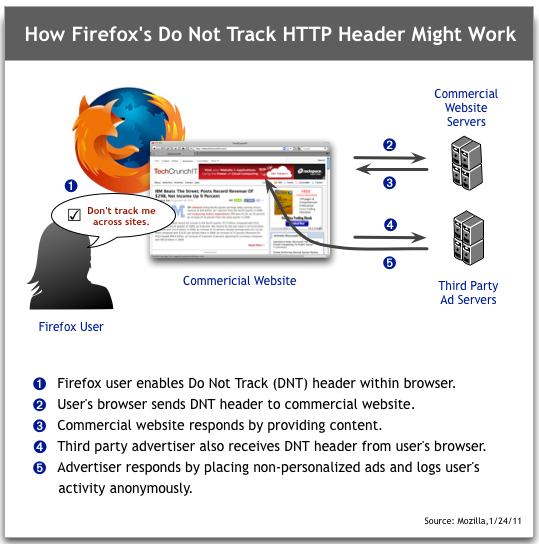Do Not Track technology gains steam, but hurdles remain

Mozilla has proposed technology that would allow the user to implement so-called Do Not Track features to stymie behavioral advertising. The big question is whether these moves by Mozilla, Google and Microsoft will be enough to take Do Not Track features mainstream.
Mozilla's draft policy---one of many steps that tech leaders are making as they ponder the Federal Trade Commission's privacy recommendations---goes like this:
- Create a feature in the browser that allows you to broadcast that you are opting out of ad-based tracking;
- Transmit a Do Not Track header with every click in Firefox;
- Web sites would then opt that user out of behavioral tracking.
Mozilla's privacy guru Alex Fowler writes in a blog post:
The Do Not Track header builds on the work the advertising networks have done to date without the cookie-based systems they make available to people online. The advantages to the header technique are that it is less complex and simple to locate and use, it is more persistent than cookie-based solutions, and it doesn’t rely on user’s finding and loading lists of ad networks and advertisers to work.
The rub: Sites and browsers would have to add the Do Not Track header to make the system work. As Fowler notes, there's a chicken and egg problem. A site that is ad supported---in other words most of the Web---is going to be reluctant to sign up first to back this feature.
Mozilla has a lot on the issue including a post about the technical specs and an analysis of the Do Not Track conundrum. Microsoft also plans to add privacy features to IE9. Regarding IE9's Do Not Track effort, Mary Jo Foley wrote in December:
Tracking Protection will be an opt-in mechanism. Microsoft officials said “Tracking Protection Lists” will enable consumers to control what third-party site content can track them when they’re online. The new feature is meant to complement other privacy features in IE, including InPrivate Browsing, a k a porn mode.
Meanwhile, the Wall Street Journal reported that Google will add a privacy feature to its Chrome browser allowing people to permanently opt out of ad targeting. The Journal notes that Google will require you to download software to make the feature work.
Add it up and Do Not Track technology is gaining steam, but it's a little fuzzy where this movement is heading. The technology fixes seem a bit clunky to date.
